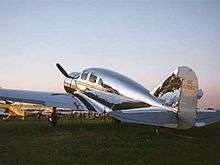Spartan Executive
| Spartan 7W Executive | |
|---|---|
 | |
| Spartan Executive NC17633 | |
| Role | Personal luxury transport |
| National origin | United States |
| Manufacturer | Spartan Aircraft Company |
| First flight | March 8, 1936[1] |
| Introduction | 1936 |
| Produced | 1936 - 1940 |
| Number built | 34 |
| Unit cost |
US$ 23,500 |
| Variants | Spartan 12W |
The Spartan 7W Executive was an aircraft produced by the Spartan Aircraft Company during the late 1930s and early 1940s. The 7W featured an all-metal fuselage as well as a retractable undercarriage. The 7W Executive was popular with affluent buyers worldwide.[1]
Development
Designed for comfort, the interior of the 7W was spacious and featured 18 in (46 cm) of slide-back seat room for front-seat passengers, arm rests, ash trays, dome lighting, deep cushions, cabin heaters, ventilators, soundproofing, large windows, and interior access to the 100 lb (45 kg) capacity luggage compartment. Built during the Great Depression, the 7W was the brainchild of company-founder William G. Skelly of Skelly Oil who desired a fast, comfortable aircraft to support his tastes and those of his rich oil-executive colleagues.
The Executive's high performance allowed the aircraft to compete in the 1939 Bendix Air Races piloted by Arlene Davis where it earned fifth place.[2] A military variant of the 7W Executive with a greenhouse canopy covering a tandem cockpit was produced by Spartan with a more powerful 600 hp (447 kW) Pratt & Whitney Wasp engine and named the Spartan 8W Zeus.[1]
Notable owners
Including the 7X, thirty-six 7W Executives were built. Notable owners of 7Ws included aircraft designer and aviator Howard Hughes, wealthy industrialist J. Paul Getty, and King Ghazi of Iraq. King Ghazi's Spartan Executive was designated "Eagle of Iraq" and was outfitted with his Coat of Arms, an extra-luxurious interior, and customized features.[3]
Variants
- Spartan 7X Executive
- (also known as Standard Seven) The first prototype, fitted with a 285 hp (213 kW) Jacobs L-5 radial engine. One built - identifiable by the very small vertical tail.

- Spartan 7W-P Executive
- Second prototype, indistinguishable from 7W. Sole example exported to China in 1937.[4]
- Spartan 7W Executive
- Production version powered by a 400 hp (298 kW) Pratt & Whitney Wasp SB radial engine. 34 built[4]
- Spartan 7W-F
- A two-seat armed version with two fixed forward firing guns and one flexibly mounted machine gun in the rear cabin, as well as provision for 10 x 25lb bombs on wing racks. One built which was later converted to 7W Executive standard.[4]
- Spartan UC-71-SP
- Spartan 7W Executives impressed by the US Army Air Corps.[4]
- Spartan 8W Zeus
- Two-seat fighter version.[4]
- Spartan 12W Executive
- Postwar nosewheel-equipped variant.[4]
Specifications (Spartan 7W Executive)
Data from [1]
General characteristics
- Crew: one, pilot
- Capacity: 3 or 4 passengers
- Length: 26 ft 10 in (8.18 m)
- Wingspan: 39 ft 0 in (11.89 m)
- Height: 8 ft 0 in (2.44 m)
- Wing area: 250 ft² (23.23 m²)
- Empty weight: 3,400 lb (1,545 kg)
- Max. takeoff weight: 4,400 lb (1,996 kg)
- Powerplant: 1 × Pratt & Whitney R-985-AN3 9-cylinder air-cooled radial engine, 450 hp (336 kW)
Performance
- Maximum speed: 223 knots (257 mph, 414 km/h)
- Cruise speed: 186 knots (215 mph, 346 km/h)
- Range: 870 nm (1,000 miles, 1,610 km)
- Service ceiling: 24,000 ft (7315 m)
- Rate of climb: 1,080 ft/min (330 m/min)
_arrives_RIAT_Fairford_10thJuly2014_arp.jpg)
Military operators
Three examples based in Montreal, formerly Royal Air Force examples used in California.[4]
The second prototype was exported to China and serialed 1309. It was damaged beyond repair and captured by the Japanese who displayed it along with other captured Chinese aircraft.[4]
At least one example was received by the LAPE (Líneas Aéreas Postales Españolas) to be used as an airliner marked as EC-AGM until requisitioned by the Spanish Republican Air Force and marked as 30+74. It was later captured by the Nationalists. Several others were purchased by the Republicans.[4]
One example (AX666) was built for King Ghazi of Iraq. Used by No. 1 Photographic Reconnaissance Unit RAF. Three examples with serials KD100, KD101 and KD102 were used in California for flight training.[4][5]
16 examples impressed from civil owners. All but two survived to return to civil service.[4][5]
See also
- Related development
- Aircraft of comparable role, configuration and era
- Airspeed Courier
- Beechcraft 17
- Clark 46 Duramold a.k.a. Fairchild Model 46
- Fairchild Model 45
- Harlow PJC-2
- Howard DGA-11, DGA-15
- Junkers Ju 60
- Lockheed Model 9 Orion
- Northrop Delta
- Related lists
- List of civil aircraft
- List of aircraft of World War II
- List of military aircraft of the United States
- List of aircraft of Canada's air forces
References
- 1 2 3 4 "American airplanes: Spartan". Aerofiles.com. 2007-10-06. Retrieved 2011-04-08.
- ↑ National Air Races
- ↑ Spartan Executive FS Review & History
- 1 2 3 4 5 6 7 8 9 10 11 Berry, Peter (1980). "The Spartan Executive" [Research Project 7233]. AAHS Journal. Huntington Beach, CA: American Aviation Historical Society. 25 (Summer): 145–153.
- 1 2 Peek, Chet; George Goodhead (1994). The Spartan Story. Three Peaks Publishing. ISBN 0-943691-16-8.
- FAA Type Certificate Data Sheet TC628
External links
| Wikimedia Commons has media related to Spartan Executive. |